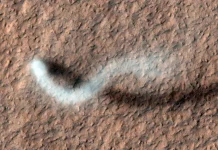
NASA’s Perseverance rover has captured one of its sharpest and most breathtaking panoramas of Mars so far, thanks to an unusually clear day on the Red Planet.
The stunning image, taken on May 26, 2025, shows remarkable detail from a location called “Falbreen” inside Jezero Crater, where the rover has been exploring since landing in February 2021.
The panoramic mosaic is made up of 96 individual photos taken by Perseverance’s Mastcam-Z camera.
In it, viewers can spot fascinating features: a large rock resting on top of a dark, crescent-shaped sand ripple, a striking boundary line separating two different types of rock, and distant hills as far as 40 miles (65 kilometers) away.
The enhanced-color version of the image makes the Martian landscape pop with contrast, revealing a surprisingly blue sky, while the natural-color version shows Mars’s more familiar reddish hue.
Jim Bell, principal investigator for Mastcam-Z at Arizona State University, explained that the unusually dust-free skies made this sharp, vivid view possible.
“The enhanced colors accentuate differences in terrain and sky, giving us a clearer understanding of the geology here,” he said.
One feature that caught the science team’s attention is the “float rock” perched on the sand ripple, about 14 feet (4.4 meters) from the rover. This type of rock likely formed somewhere else before being moved to its current location—possibly by wind, water, or even a landslide—long before the sand ripple itself formed.
Another point of interest in the image is a bright white circular patch near the bottom left of center.
This is an abrasion spot created by Perseverance’s drill, the 43rd such abrasion since the rover landed.
About two inches (five centimeters) across, the patch reveals the fresh rock surface beneath the dusty exterior, helping scientists decide whether to drill a core sample for storage in one of the rover’s titanium sample tubes. This particular abrasion was made on May 22, followed by close-up scientific analysis two days later.
Falbreen is especially intriguing to researchers because it may contain some of the oldest terrain Perseverance has studied—possibly older than Jezero Crater itself. Tracks from the rover’s journey to this location can be seen in the image, veering off toward another previous stop nicknamed “Kenmore.”
A clear geological boundary is also visible, where light-colored, olivine-rich rocks closer to the rover meet darker, clay-bearing rocks farther away. This contact zone offers valuable clues about Mars’s ancient environmental history.
NASA leaders say breathtaking views like this are a glimpse of what future astronauts might see with their own eyes.
The agency’s Artemis program aims to return humans to the Moon as a stepping stone for eventual crewed missions to Mars—missions that could one day explore landscapes just like Falbreen in person.
Source: NASA.



